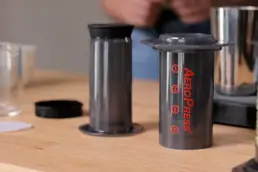Table of Contents
ToggleWhen you think about espresso, one image often comes to mind: a small cup topped with a golden-brown layer of foam, known as crema. For many coffee lovers, this layer is more than just aesthetics – it’s the hallmark of a well-prepared shot. But what exactly is crema, and why does it matter so much in the world of espresso?
What Is Crema?
Crema is the golden, slightly foamy layer that sits on top of a freshly pulled espresso shot. It forms when hot pressurized water emulsifies the natural coffee oils and traps microbubbles of carbon dioxide released during extraction. The result is a rich, velvety crown that signals freshness and quality.
This thin layer is not just for show. Crema carries intense aromas and subtle flavors, making the first sip of espresso both fragrant and complex.
Why Crema Matters
Crema plays several important roles in the espresso experience:
-
Flavor Enhancement
Crema contains concentrated aromatic compounds that give espresso its bold first impression. It delivers hints of caramel, chocolate, nuttiness, or even fruity notes depending on the beans and roast profile. -
Texture and Mouthfeel
Beyond flavor, crema adds body to the shot. It gives espresso that smooth, velvety mouthfeel which lingers after each sip. Without it, the drink often feels flat. -
Freshness Indicator
A rich crema shows that your beans are fresh and were ground just before brewing. Stale beans or poorly stored coffee often result in weak or nonexistent crema. -
Visual Appeal
Coffee is as much about experience as it is about taste. A golden-brown crema signals craftsmanship, inviting you to enjoy the richness of the shot.
Factors That Affect Crema
Not all espresso shots produce the same crema. Several elements influence its appearance and quality:
-
Bean Type: Arabica beans create a lighter, more delicate crema, while Robusta beans yield thicker, darker crema with more bitterness. Many blends combine both for balance.
-
Roast Level: Medium and medium-dark roasts tend to produce the most stable crema. Very dark roasts often have less.
-
Freshness: Beans roasted within the last 2–4 weeks create stronger crema. Coffee that’s too old loses its ability to produce it.
-
Grind and Pressure: A fine grind and the right machine pressure (usually around 9 bars) are essential. Too coarse or too fine, and crema suffers.
Does More Crema Mean Better Espresso?
It’s tempting to believe that more crema equals better espresso, but that isn’t always true. While crema enhances the sensory experience, the quality of the espresso depends on the balance of flavors, extraction, and bean quality.
Sometimes, a shot with little crema may still taste exceptional if brewed with care. On the other hand, a thick crema can mask bitterness or poor extraction. In short, crema is a guide — not the only measure of excellence.
How to Get the Perfect Crema at Home
If you’re brewing espresso at home, here are some simple steps to maximize crema:
-
Use fresh beans roasted within 2–4 weeks.
-
Grind just before brewing with a burr grinder.
-
Ensure your machine maintains consistent pressure and temperature.
-
Aim for a fine grind, but not too powdery.
-
Experiment with blends that include a touch of Robusta for thicker crema.
Final Sip
Crema is more than just a pretty layer. It’s the golden crown that enhances aroma, texture, and the overall espresso experience. While it doesn’t guarantee a perfect shot, it often reflects the freshness of your beans, the quality of your grind, and the precision of your brewing technique.
Next time you take a sip of espresso, pause for a moment and appreciate the crema. It’s a small detail that holds the essence of a big coffee tradition.




